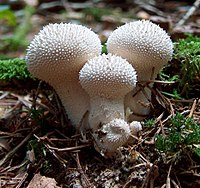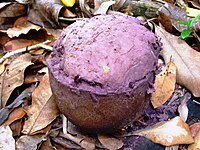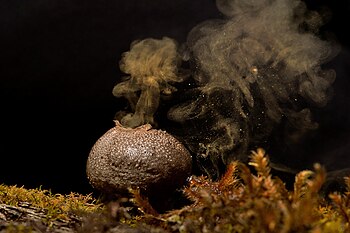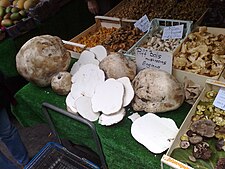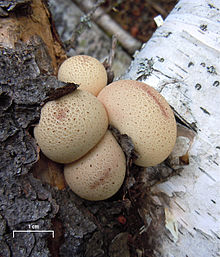
The Agaricaceae are a family of basidiomycete fungi and include the genus Agaricus, as well as basidiomycetes previously classified in the families Tulostomataceae, Lepiotaceae, and Lycoperdaceae.
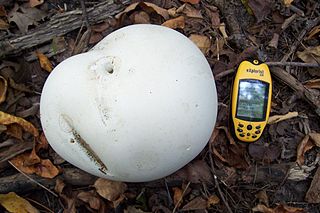
Calvatia gigantea, commonly known as the giant puffball, is a puffball mushroom commonly found in meadows, fields, and deciduous forests usually in late summer and autumn. It is found in temperate areas throughout the world.
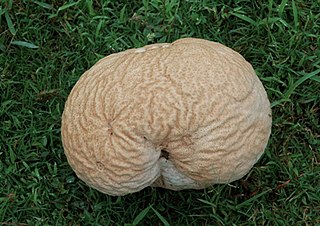
Calvatia is a genus of puffball mushrooms that includes the spectacular giant puffball C. gigantea. It was formerly classified within the now-obsolete order Lycoperdales, which, following a restructuring of fungal taxonomy brought about by molecular phylogeny, has been split; the puffballs, Calvatia spp. are now placed in the family Agaricaceae of the order Agaricales.

Lycoperdon perlatum, popularly known as the common puffball, warted puffball, gem-studded puffball or devil's snuff-box, is a species of puffball fungus in the family Agaricaceae. A widespread species with a cosmopolitan distribution, it is a medium-sized puffball with a round fruit body tapering to a wide stalk, and dimensions of 1.5 to 6 cm wide by 3 to 10 cm tall. It is off-white with a top covered in short spiny bumps or "jewels", which are easily rubbed off to leave a netlike pattern on the surface. When mature it becomes brown, and a hole in the top opens to release spores in a burst when the body is compressed by touch or falling raindrops.

Calvatia craniiformis, commonly known as the brain puffball or the skull-shaped puffball, is a species of puffball fungus in the family Agaricaceae. It is found in Asia, Australia, and North America, where it grows on the ground in open woods. Its name, derived from the same Latin root as cranium, alludes to its resemblance to an animal's brain. The skull-shaped fruit body is 8–20 cm (3–8 in) broad by 6–20 cm (2–8 in) tall and white to tan. Initially smooth, the skin (peridium) develops wrinkles and folds as it matures, cracking and flaking with age. The peridium eventually sloughs away, exposing a powdery yellow-brown to greenish-yellow spore mass. The puffball is edible when the gleba is still white and firm, before it matures to become yellow-brown and powdery. Mature specimens have been used in the traditional or folk medicines of China, Japan, and the Ojibwe as a hemostatic or wound dressing agent. Several bioactive compounds have been isolated and identified from the brain puffball.
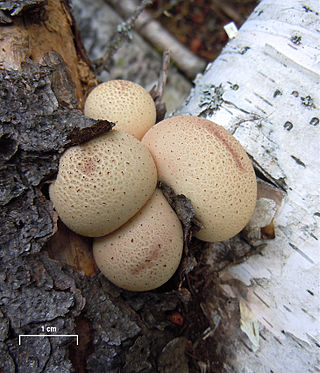
Apioperdon pyriforme commonly known as the pear-shaped puffball or stump puffball, is a saprobic fungus present throughout much of the world. Emerging in autumn, this puffball is common and abundant on decaying logs of both deciduous and coniferous wood. It is considered a choice edible when still immature and the inner flesh is white. It is often called Lycoperdon pyriforme, but was transferred to Apioperdon in 2017 based on phylogenetic and morphological differences. It is the only species in the genus.

Podaxis pistillaris is a very distinctive relative of the puffballs. It is commonly known as the desert shaggy mane, as it bears a superficial resemblance to the shaggy mane, Coprinus comatus; this species lacks the latter's deliquescing gills, however, and the two are not closely related. It grows to 15 cm high and has a hard, woody stem. The large cap, which protects the blackish spore-bearing tissue, splits, and usually falls away at maturity, allowing the spores to be dispersed by wind. Large numbers may appear after soaking rains. It thrives in deserts and semi-deserts of Australia and other countries, often found on termite mounds in South Africa. In the Hawaiian Islands, it is frequently encountered along roadsides and in disturbed areas on the dry sides of the islands, especially in the Kona area of Hawaii and the Kihei area of Maui.

Bovista is a genus of fungi commonly known as the true puffballs. It was formerly classified within the now-obsolete order Lycoperdales, which, following a restructuring of fungal taxonomy brought about by molecular phylogeny, has been split; the species of Bovista are now placed in the family Agaricaceae of the order Agaricales. Bovista species have a collectively widespread distribution, and are found largely in temperate regions of the world. Various species have historically been used in homeopathic preparations.

Bovista plumbea, also referred to as the paltry puffball, is a small puffball mushroom commonly found in Western Europe and California, white when young and greyish in age. Easily confused with immature Bovista dermoxantha, it is attached to the substrate by a tuft of mycelium.

Bovista nigrescens, commonly referred to as the brown puffball or black bovist, is an edible cream white or brown puffball. Phylogenetic relationships between Bovista nigrescens and species of Lycoperdaceae were established based on ITS and LSU sequence data from north European taxa.

Handkea utriformis, synonymous with Lycoperdon utriforme, Lycoperdon caelatum or Calvatia utriformis, is a species of the puffball family Lycoperdaceae. A rather large mushroom, it may reach dimensions of up to 25 cm (10 in) broad by 20 cm (8 in) tall. It is commonly known as the mosaic puffball, a reference to the polygonal-shaped segments the outer surface of the fruiting body develops as it matures. Widespread in northern temperate zones, it is found frequently on pastures and sandy heaths, and is edible when young. H. utriformis has antibiotic activity against a number of bacteria, and can bioaccumulate the trace metals copper and zinc to relatively high concentrations.

Handkea is a genus of puffball mushrooms in the family Agaricaceae. In 1989, German mycologist Hanns Kreisel described the genus Handkea to include species of Calvatia with distinct microscopic features, including a unique type of capillitium, with curvy slits instead of the usual pores. Although accepted by some authors, the genus concept has been rejected by others.

Bovista aestivalis is a small puffball in the family Agaricaceae. It is generally found in the coastal regions of California, but was reported from Korea in 2015. This fungus is often confused with Bovista dermoxantha, because of its similar peridium, and Bovista plumbea. The surest way to tell the species apart is to examine the spores and exoperidium, respectively, with a microscope.

Calvatia cyathiformis, or purple-spored puffball, is a large edible saprobic species of Calvatia. This terrestrial puffball has purplish or purple-brown spores, which distinguish it from other large Agaricales. It is found mostly in prairie or grasslands of North America, Australia, and Saiyan Village, Pakistan.

Calbovista is a fungal genus containing the single species Calbovista subsculpta, commonly known as the sculptured puffball, sculptured giant puffball, and warted giant puffball. It is a common puffball of the Rocky Mountains and Pacific Coast ranges of western North America. The puffball is more or less round with a diameter of up to 15 cm (6 in), white becoming brownish in age, and covered with shallow pyramid-shaped plates or scales. It fruits singly or in groups along roads and in open woods at high elevations, from summer to autumn.
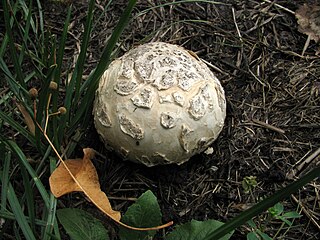
Mycenastrum is a fungal genus in the family Agaricaceae. The genus is monotypic, containing one widely distributed species, Mycenastrum corium, known by various common names: the giant pasture puffball, leathery puffball, or tough puffball. The roughly spherical to turnip-shaped puffball-like fruit bodies grow to a diameter of 6–24 cm (2–9 in). Initially covered by a thick, felted, whitish layer, the puffballs develop a characteristic checkered skin (peridium) in age. When the internal spore mass, the gleba, is firm and white, the puffball is edible, although some individuals may suffer mild gastrointestinal symptoms after eating it. As the spores mature, the gleba turns first yellowish then purplish brown. Spores are released when the peridium eventually splits open into irregularly shaped sections. Microscopically, the gleba consists of spherical, dark brown spores with rounded bumps on their surfaces, and a capillitium—intricately branched fibers that form long thorn-like spines. The puffball grows on or in the ground in prairie or desert habitats. Although widely distributed, it is not commonly encountered. Mycenastrum corium is a threatened species in Europe.

Lycoperdon echinatum, commonly known as the spiny puffball or the spring puffball, is a type of puffball mushroom in the family Agaricaceae. The saprobic species has been found in Africa, Europe, Central America, and North America, where it grows on soil in deciduous woods, glades, and pastures. It has been proposed that North American specimens be considered a separate species, Lycoperdon americanum, but this suggestion has not been followed by most authors. Molecular analysis indicates that L. echinatum is closely related to the puffball genus Handkea.

The gasteroid fungi are a group of fungi in the Basidiomycota. Species were formerly placed in the obsolete class Gasteromycetes Fr., or the equally obsolete order Gasteromycetales Rea, because they produce spores inside their basidiocarps rather than on an outer surface. However, the class is polyphyletic, as such species—which include puffballs, earthstars, stinkhorns, and false truffles—are not closely related to each other. Because they are often studied as a group, it has been convenient to retain the informal (non-taxonomic) name of "gasteroid fungi".

Handkea excipuliformis, commonly known as the pestle puffball or long-stemmed puffball, is a species of the family Agaricaceae. A rather large puffball, it may reach dimensions of up to 15 cm (5.9 in) broad by 25 cm (9.8 in) tall. Widespread in northern temperate zones, it is found frequently on pastures and sandy heaths.

Lycoperdon marginatum, commonly known as the peeling puffball, is a type of puffball mushroom in the genus Lycoperdon. A common species, it is found in Europe and North America, where it grows on the ground. It is characterized by the way that the spiny outer layer peels off in sheets.
